U-M head of research Stephen Forrest discusses the university's $1.27B research budget, its importance to Ann Arbor and 3,000 talking cars
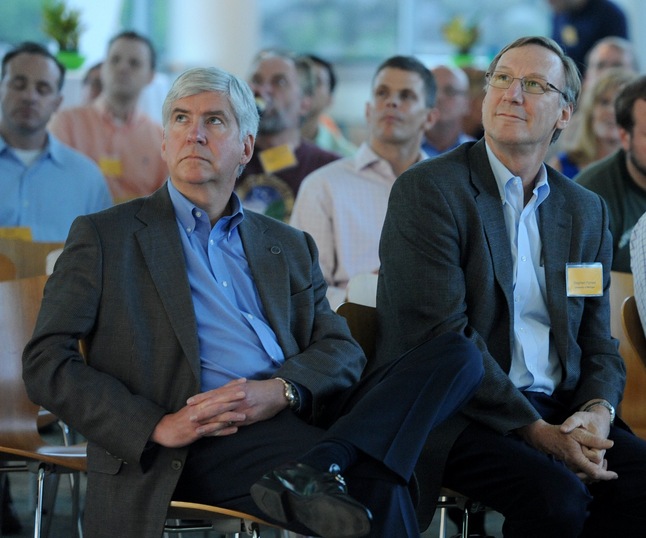
Michigan Gov. Rick Snyder and Stephen Forrest during a U-M conference on entrepreneurialism this summer.
Angela J. Cesere | AnnArbor.com
Yet the school's Vice President for Research Stephen Forrest is quick to caution that the bulk of research and development funding might stagnate or grow slower next year as the federal government works to reduce spending.
In the six years it has taken for the Midwestern school's research enterprise to grow by more than $470 million, reaching $1.27 billion, Forrest has experienced Ann Arbor's own business landscape change and slowly become a hotbed for entrepreneurial activity.
AnnArbor.com sat down last week with Forrest in his north campus office to discuss the complex world of research funding, the rise of collaboration in higher education and the changing business landscape of Ann Arbor and Southeast Michigan.
Here's what the physicist-turned-administrator had to say:
On the effects of sequestration, a federal policy that would drastically cut federally sponsored research if allowed to go into effect on Jan. 2, 2013. (Many experts believe Congress will stop the law from taking effect. U-M has not accounted for sequestration in its fiscal 2013 budget):
It would put about an 8.2 percent cap on all of our research funding, not just NIH (National Institutes of Health) but also NSF (National Science Foundation) the Department of Transportation, Department of Defense, across the board. It would be quite devastating for the entire nation. It would probably send us into a depression if it really came about.

A physicist by trade, Stephen Forrest has been the vice president of research at the University of Michigan since 2006.
We have been trying to the extent that we can to prepare, that is to anticipate what sort of changes we would have to adapt to if this happened, but it's very difficult to plan for such deep and sort of broad cuts. It's a rather blunt knife to put to us.
On the funding landscape in Washington and how U-M will maintain its share of federal research if funds decline or stagnate:
We still have a budget deficit, we still have a significant downturn in the economy that we're struggling out of. What we have found in the last two years is that Congress has been voting for positive increases in what I would call the innovation budget, which is all of these agencies that are funding research and development across the country.
I think there is a very bipartisan belief that innovation is really the key, and has long been the key, to economic wellbeing of this country. While there is an awful lot of noise that comes out of our political system, when they get right down to it everybody seems to come around to that fact. We have seen very modest, but nevertheless positive, growth in the innovation budget... over the last two years, when one would think that's a surprising outcome.
Going forward, while we still have very difficult economic circumstances to deal with, still a large deficit. Barring sequestration... we expect rather slow growth and maybe even a slight decline in the total research budget overall for the nation.
We just have to become more competitive, try to gain market share from other universities and research institutions from around the country. And we've been very successful in doing that so far, so we hope to continue to do so, even in times that are not as positive as they have been in the past. But there have been periods in the post-World War II era when the federal research budget has been flat or declined, so this is not something new. We see lots of ups and downs.
On how U-M has increased its market share of federal research funds over time (In 2011 federally sponsored research funding at the school was $825 million, a share second only to Johns Hopkins University.):
We have been focusing a lot on allowing our faculty to be entrepreneurial. So there's just so many things that are going on. We do a lot of internal funding of our own research. In this last budget $300 million came from the university itself, so we're self-investing to make sure that our faculty are doing the work that positions them very competitively to attract external funds....
One (factor) obviously is just scale. But in some cases, like NIH, we're really hitting above our weight class. We're unusually good at interdisciplinary research where something like a system has to emerge from the research. The recent example of the automobile safety pilot: There's very few universities that can conceive of wiring 3,000 automobiles to interact with each other, to get the town on board so that we can put up microwave stations and gather information through the town's Internet backbone. That's a big systems-level project.
On how research contracts awarded through the American Recovery and Reinvestment Act of 2009, better known as the stimulus package, are drying up:
We've just seen that in the latest budget: The effect of the stimulus package going away. For the first time in a long time the total federal part of our budget, that fraction has actually declined 3.6 percent. If you look at it, more than that (percentage) was due to a decline in ARRA funds. If you just looked at AARA funds we would have declined 8.5 percent, so we actually grew underlying the stimulus package. The biggest hit was NIH, where we took an 8.6 percent decline.
Even if you backed out the ARRA funding, our NIH grew this year behind it all. We're actually still on a very strong growth trajectory, quite amazingly, which means we're continuing to grow our market share compared to our peers. That was very encouraging. We knew the ARRA funds were going to go away and this was the year when we were thinking they would probably start to really diminish. I was actually looking for a total, significant decline and we didn't see it and that's really good news.
In the future they won't be there. This was the big year of the drop, and next year it will be a lot less because it becomes a less and less part of our research expenditures. We still have some big contracts moving through the system but overall I think we've seen the worst of it this year.
On how much federal research money U-M is expecting next year:
I'm trying not to build expectations, so I'm sort of looking to flat to a small decline. But my predictive abilities on these things are not particularly good.... It could be quite good, but for planning sake we should plan on flat to a small decline.
On the $108 million acquisition of the North Campus Research Complex and how collaboration has become increasingly embraced throughout higher education, and specifically at U-M:
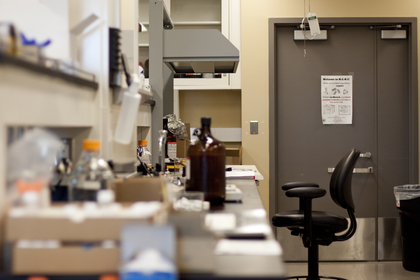
A lab at the University of Michigan.
Jeffrey Smith | AnnArbor.com
I have worked at three universities (the University of Southern California, Princeton University and U-M) and I have close relationship with a couple more. University of Michigan has by far the lowest barriers to work between departments.
People feel motivated to come together in teams and they're not so worried that they won't get credit in their own departments for their contribution. It's a cultural thing, it's hard to put your finger on, but it has developed over the years. Part of it is because of the nature of the College of Engineering and the Medical School, and their close collaboration that came together over the years. It's very difficult to tell cause and effect.
Almost every problem of scale that we envision involves more than one school.... When you have quality among disciplines it's very conducive to working together.
On the role of art at a research university:
There's a large a collaboration between what I would almost term all the art schools, which is engineering, architecture, art and design, and music, theater and dance.... Maybe people don't always think of engineering as art, but it's always creating. It's creating things that have never existed before....
Whether creation goes on in the laboratory or the studio, it's all creation, and that's what comes naturally to a research university. Art informs us in so many ways. As a scientist I use it all the time in my thinking.
On increasing industry funding, which accounted for $42.8 million of the total $1.27 billion research budget in fiscal 2012:
We're working very, very hard on it because one has to again have rather modest goals because it's still a small fraction of the total.
So much of our federal funding depends on our industry partnership. The federal funding demands that we have industrial partners on our proposals. If we don't have these alliances, a lot of our federal funding would vanish as well. So it's a catalyst. It catalyzes a different class of problems and a different type of partnership. It's absolutely essential.
Now, would we like to see it grow more rapidly? Absolutely. Because we contribute, and I think industry feels we contribute quite substantially, to the health of these industries. The problem being that industry goes through ups and downs with the economy just like anything else, so these types of money is not always free. It's more vulnerable to economic changes.
Michigan is very rapidly coming out of a very deep depression. The rest of the country has gone through the Great Recession, we've had our own depression here. The feeling of industry and how we have partnered during this bad time, as well as during good times, has been very positive.
We're doing everything we can to make it happen. We have a business engagement center. We have all kinds of incentives to get our own faculty to build their own enterprises. It's across the board, we're looking at the ecosystem here to working with industry.
On conflicts of interest in research:
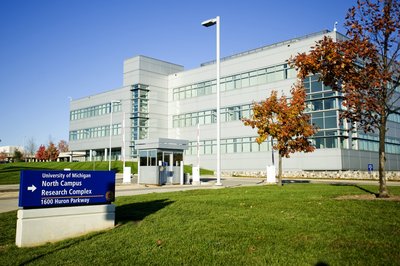
Part of the North Campus Research Complex, purchased by University of Michigan from Pfizer for $108 million more than three years ago.
Joseph Tobianski I AnnArbor.com
Certainly conflicts are a concern. We feel that conflicts of interest are not a bad thing as long as they are managed appropriately and we have mechanisms to manage them. But one should not be under the illusion that federal funding is completely free of conflicts and trouble as well.
Every agency, whether it's an industrial one or a federal one or even a foundation one, they all have their own self interests. They are funding the research for their interest and we of course are doing research for ours, and in there is always the opportunity for conflict and we manage them and we have a tremendous experience to do so. Industry presents some particular challenges and I think by-and-large we've done very well in keeping the research untainted by undue external influence.
On reorganizing U-M's Office of Research and Sponsored Projects, the unit that oversees all grant and contract applications filed by U-M faculty (For two years, U-M gathered committees and consultants to design the restructured office, which launched this spring.):
The idea is always to lower the barriers to faculty getting their proposals done. This is a big institution. It can at times be very bureaucratic.
When a faculty member writes a proposal to an agency, to industry, that actually turns out to be quite a complex affair. It's not just about the science, you have to get budgets done, you have to worry about regulatory aspects and so on. There's layers. You have to assign space, you have to assign personnel. All of that is part of the proposal writing process. The harder you make that by creating bureaucratic barriers, the less likely it is that a faculty will write that next proposal. This is part of our concept of being competitive and gaining market share.
What we have tried to do is to streamline that process quite dramatically.... We created a direct reporting line to me as the vice president for research. We have an associate vice president now who runs the office, Daryl Weinert, who used to be the executive director of the business engagement center. He's all about customer service, because that's what the business engagement center is. So we're trying to make it a very customer service-oriented organization where the customer ultimately is the faculty member. You can think of the agency as the customer, but actually if you get it right with the faculty member you get it right with the agency....
Our research budget has grown quite dramatically... and our entire contracting infrastructure has not grown at the same pace and so it was getting to be a difficult fit and we knew it had to be improved.
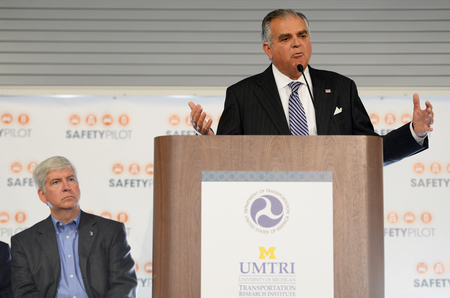
U.S. Secretary of Transportation Ray LaHood speaks as Michigan Gov. Rick Snyder looks on at the launch of a vehicle-to-vehicle communication project in Ann Arbor in August.
Melanie Maxwell | AnnArbor.com
What's really exciting about the safety pilot, the interconnected vehicle piece, is that it really is looking at an entirely new generation. More than a new generation, it's a new way of looking at transportation....
Ultimately I see our region as poised to be the next really substantial, integrated, industrial core of this nation. If you think about Silicon Valley, it's an industrial cluster that started basically in the 1970s. It was a place where electronics developed into an industry that has really determined the fortunes both of this country, the world itself, but certainly of the region.
Michigan has been pretty resistant to forming a collaborative industrial cluster, although it's always been here in massive pieces. It's built around advanced manufacturing. Basically, we all know the automotive industry, but that's not the only thing. We have enormous manufacturing capability and skill within our region.
We have never had a close integration of that advanced manufacturing piece and the university and educational resources of the region, which has really created these sort of condensates, if you will, in other parts of the country: Seattle, Los Angeles, the Bay Area and Boston are just a few.
If you look forward, and with the near-death experience that was faced by the automotive industry, they became more externally focused than they've been in the past. And the University of Michigan in the meantime, as well as the other research corridor universities, are also more externally focused. We're not simply ivory towers any more. We know we need to work with the industrial sector.
That's the really grand vision. It all starts in a sense with the automobile and this concept of the interconnected vehicle, and we've got this really amazing opportunity... to pilot this concept here, right here in our city, in Southeast Michigan, with our industrial partners and the automotive companies. So we have to build on that, expand on that.
On what Ann Arbor would look like without the University of Michigan:
What Ann Arbor would look like without the University of Michigan is another industrial town that was in decline. It is the engine of Ann Arbor.
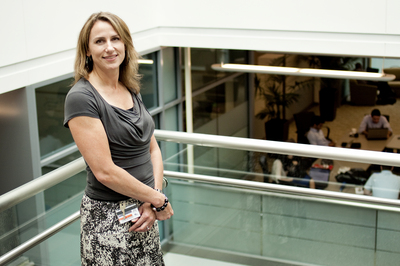
Laura Schrader and her company 3D Biomatrix were one of the first tenants of the Venture Accelerator.
Jeffrey Smith | AnnArbor.com
We started this thing a year ago, it's completely full. There's 19 companies. Obviously we weren't ambitious enough. When we started it off we wanted it to pay for itself, so it was a business proposition in many respects. Could we make this sustainable? We thought 'Well, we hope we have enough companies.' And all of a sudden we're full. I think that tells you we have enormous capacity here, there's enormous creativity to grow this region.
If you walk downtown Ann Arbor it's a different place than even when I started here in 2006. There are these companies all around downtown. Baraccuda Networks moves into Borders. it's everywhere. Arbor Networks has become big and they've had to move out and move in again, and SPARK. It's not just in town, but it's in our surrounding region.
There's something going on here and it's pretty exciting and I think the Venture Accelerator is just at the sharp tip of the spear. But there's so much behind it and so many other things too. So we're trying to spin our companies out.
It used to be we just spun them right out of the state, well they're staying now. How about that? Six years ago they weren't staying. Not many. Now we're gaining a critical mass.
Kellie Woodhouse covers higher education for AnnArbor.com. Reach her at kelliewoodhouse@annarbor.com or 734-623-4602 and follow her on twitter.


Comments
OU812
Tue, Oct 9, 2012 : 1:26 p.m.
Once again Forrest makes statements against the infrastructure that he at least FINALLY admits was not well-funded. Yet, he continues to push "customer service" as the credo. While service is certainly at the forefront of getting research funded unencumbered, too many times it is forgotten that compliance is a major factor in what is holding things up. Also, the researchers themselves forget that the government and private industry have regulations, standards, etc. to deal with BEFORE you can get those dollar bills in your hands to do the research. While this should be a no-brainer, many faculty have only themselves to blame for their lack of proper planning in the beginning stages of their own research. Applying to get the money to do the research should be factored as part of the research overall plan. It cannot be an afterthought. Also, although we have a few small, growing-to-large companies that have moved into the area, like Baraccuda, we need not delude ourselves that A2 is some hotbed of competition for Silicon Valley. Many A2 companies are here as a labor of love- a local who lived here brings business back and keeps it here by their own choice and sentiment for the area- it's got nothing to do with actually competing in the world marketplace. People truly need to open their eyes and ears and dig a little deeper at the seeming boom around A2/Michigan for small/growing businesses. Other states have a much more thriving small business sector. We do nothing tax-wise and locally, with A2 city laws to truly help A2 entrepreneurs thrive. SPARK is little more than that...it's not catching much on fire.
LXIX
Mon, Oct 8, 2012 : 9:09 p.m.
There it is In a nutshell, Industry gives up a their pittance of 3.3% for R&D and the taxpayeris squeezed for the rest. It is also called corporate welfare where business profit originates from the government - Socialism. The smartcar serves one purpose - remote tracking. If the recent NYTimes article has any meaning, when it says the vast majority of internet users do NOT want to be tracked and flacked with Google profit ads (sorry AAPS) then consumer demand for the transpo-net product will vanish about as fast as the soon-to-disappear federal corporate trough. Even if the Big Gov likes snoopmobiles, without a demand from the public the idea is doa - unless manufacturer-installed tracking is made "manadatory" and consumer paid for safety purposes of course. Where's my Tesla?
Alpha Alpha
Mon, Oct 8, 2012 : 3:12 p.m.
Great article, Ms. Woodhouse. Any thoughts on why "...they're staying now..." ? Thank you.